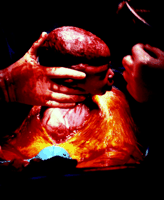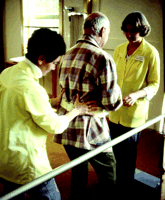This week in the BMJ
Volume 328, Number 7441, Issue of 20 Mar 2004Safe interval for emergency caesarean section is 75 minutes
(Short) training does not improve peer review
KISS, say GPs
Adding amynoglycoside to
lactam does not improve results
Preventing falls makes hospital stay safer
Heart attack patients need better secondary prevention
Safe interval for emergency caesarean section is 75 minutes
When the decision to deliver by caesarean section is made, time to intervention should be less than 75 minutes to avoid poor maternal and baby outcomes. Thomas and colleagues (p 665) analysed 17 780 singleton births by caesarean section in Wales and England in 2000. They found that, compared with deliveries completed within 15 minutes of the decision for an emergency caesarean section, mothers' and babies' outcomes did not differ from deliveries within 75 minutes. Babies delivered after 75 minutes were more likely to have an Apgar score of less than 7, and their mothers were more likely to require special care. Never the less, the target of 30 minutes should remain as the benchmark for service provision, the authors say.
|
(Short) training does not improve peer review
One day of face to face training and short training packages have only a slight impact on the quality of peer review, and the improvement is lost after six months. Schroter and colleagues (p 673) randomised 609 reviewers to a one day training workshop in peer review, a self taught training package, or to no intervention. They found that reviewers who had training detected more errors and were more likely to recommend rejection; they were not faster at reviewing papers and after six months the quality of review in the groups did not differ.
KISS, say GPs
General practitioners prefer a simple criterion model for revalidation. Bruce and colleagues (p 687) compared two models of revalidation for general practitioners: a simpler criterion model and an educational outcome model combining revalidation with continuing professional development. Although the criterion model was preferred by general practitioners and can be implemented more easily, both models helped to change doctors' practice and helped make them better doctors. Doctors will require support from their colleagues and trainers to work through either model completely.
Adding amynoglycoside to  lactam does not improve results
lactam does not improve results
In patients with neutropenia and sepsis, mortality when  lactams and aminoglycosides are used together is no different from
lactams and aminoglycosides are used together is no different from  lactams used alone, but the risk of adverse effect is increased. Paul and colleagues (p 668) reviewed 64 trials with 7586 patients and found that the combination did not improve survival or reduce superinfection or colonisation rates; nephrotoxicity was more common with combination therapy. The overall quality of the studies was poor, the authors say, and it is of concern that studies comparing different
lactams used alone, but the risk of adverse effect is increased. Paul and colleagues (p 668) reviewed 64 trials with 7586 patients and found that the combination did not improve survival or reduce superinfection or colonisation rates; nephrotoxicity was more common with combination therapy. The overall quality of the studies was poor, the authors say, and it is of concern that studies comparing different  lactams may not detect important harm to patients.
lactams may not detect important harm to patients.
|
Preventing falls makes hospital stay safer
A multiple intervention programme to prevent falls can make in-hospital stay safer for patients. Haines and colleagues (p 676) randomised 626 men and women (mean age 80) to the intervention, consisting of an information brochure, an exercise and education programme, and a hip protector, or to standard care. They found that participants in the programme had 30% fewer falls; more didn't fall at all; and injuries from falls were less common. Reducing falls in elderly patients admitted to hospital will benefit the patients and reduce additional costs, say the authors. In an accompanying editorial (p 653), Gillespie highlights the impact of falling on the quality of people's lives, especially the psychological issues related to the fear of falling and self imposed restriction of activity, and she reflects on the potential dangers associated with a risk management culture.
|
Heart attack patients need better secondary prevention
Even though secondary prevention after acute myocardial infarction reduces the risk of recurrence and death, its implementation remains suboptimal. On page 693 Dalal and colleagues describe drug and other treatments available after myocardial infarction. Antiplatelet drugs, statins, angiotensin converting enzyme inhibitors, and  blockers are the four main prophylactic drugs. Organisation of care and nurse led clinics for secondary prevention, cardiac rehabilitation, and smoking cessation may improve outcomes, but not all patients receive all the treatment they need. Up to 20% of patients are depressed after myocardial infarction, and this is associated with increased mortality.
blockers are the four main prophylactic drugs. Organisation of care and nurse led clinics for secondary prevention, cardiac rehabilitation, and smoking cessation may improve outcomes, but not all patients receive all the treatment they need. Up to 20% of patients are depressed after myocardial infarction, and this is associated with increased mortality.


